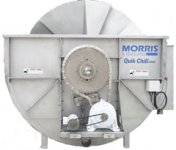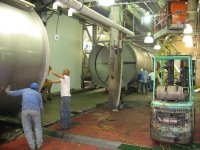I would use the teeth on the gear and count teeth except for the fact that when the gear stops it could easily stop on a tooth keeping the timer from timing? So I made a "flag" (a piece of metal sticking out away from the gear teeth)to limit the likelyhood or the flag stopping over the sensor.
Because of these two facts, you should consider sensing the gear teeth instead of a flag (target). By the time your flag comes around again, 10 or 20 seconds may have passed and it will be too late to save the next auger. Even the distance of one tooth-travel may be too late, but your chances are a lot better.The reason the alarm is important is because of the tourque on the auger (14 ft diameter). If one part of the auger were to stop, it could literaly blow the end out of the next piece.
By using the two-timer method (ON and OFF times for each gear tooth), you will make sure to get an alarm no matter where an auger stops. That eliminates your main concern for not sensing the gear teeth, and you sure do have a good reason for looking at the teeth instead of at flags.
PS: In my previous program, the Rung 002 comment says "...the alarm will always go off if the gear stops." What I meant was that the alarm will always be triggered -- it will go ON.
Last edited:




